Jun
18
2012
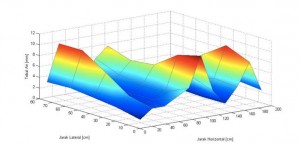 This study discusses about monitoring system of hydraulic gradient as a parameter which observed to detect the occurrence of landslide on agricultural land-use in the sub district of Kalibawang, Kulon Progo, Yogyakarta, Indonesia. Hydraulic gradient was observed by using low-cost sensor, gypsum block, combined with AVR LMC555, single chip microcontroller, to read soil moisture content. Sensor node positioned as grid distribution to provide equitable and accurate measurement during soil deformation. Wireless sensor networks technology, IQ Radio Frequency( IQRF) and web databases introduced as an alternative technology which can applied to simplify data transmission and information distribution. Hydraulic gradient was observed with the visual observation of soil moisture content as a head approximation in each sensor node.
This study discusses about monitoring system of hydraulic gradient as a parameter which observed to detect the occurrence of landslide on agricultural land-use in the sub district of Kalibawang, Kulon Progo, Yogyakarta, Indonesia. Hydraulic gradient was observed by using low-cost sensor, gypsum block, combined with AVR LMC555, single chip microcontroller, to read soil moisture content. Sensor node positioned as grid distribution to provide equitable and accurate measurement during soil deformation. Wireless sensor networks technology, IQ Radio Frequency( IQRF) and web databases introduced as an alternative technology which can applied to simplify data transmission and information distribution. Hydraulic gradient was observed with the visual observation of soil moisture content as a head approximation in each sensor node. 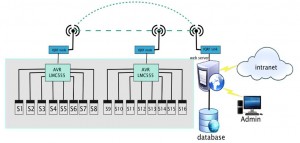 Distribution of soil moisture content in grid system displayed in three dimensional graph to represent soil condition during rainfall induced within a certain time. Verification test of the proposed monitoring system was carried out in the laboratory stage to study about the behavior of the hydraulic gradient and performance of monitoring system. Soil layer was prepared using soil test box (0.74 m x 1.85 m x 0.25 m) filled with the equal soil in research site. Rainfall generator was adapted to supply the intensity of rainfall up to 115.5 mm/day. Further development, low-cost sensor and concept of hydraulic gradient as a hydraulic parameter of landslide occurrence can be use for early warning system with combination with other commercial sensors to enhance the accuracy of the system.
Distribution of soil moisture content in grid system displayed in three dimensional graph to represent soil condition during rainfall induced within a certain time. Verification test of the proposed monitoring system was carried out in the laboratory stage to study about the behavior of the hydraulic gradient and performance of monitoring system. Soil layer was prepared using soil test box (0.74 m x 1.85 m x 0.25 m) filled with the equal soil in research site. Rainfall generator was adapted to supply the intensity of rainfall up to 115.5 mm/day. Further development, low-cost sensor and concept of hydraulic gradient as a hydraulic parameter of landslide occurrence can be use for early warning system with combination with other commercial sensors to enhance the accuracy of the system.
Nov
27
2009
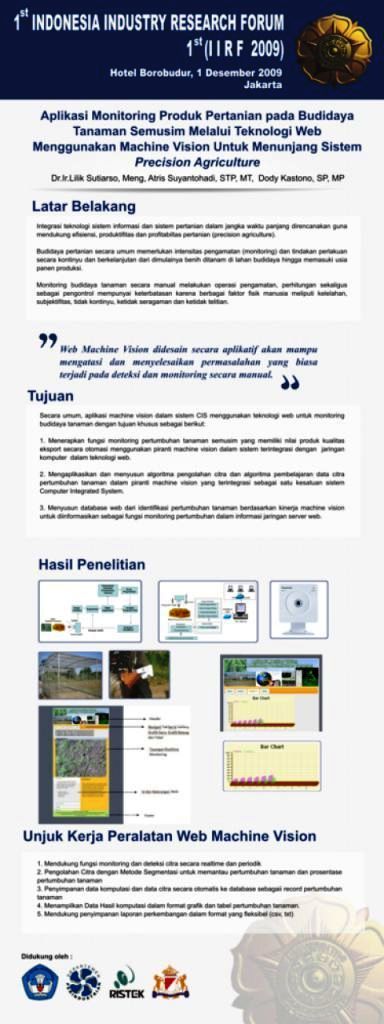 Nowadays, demand for integrating between information technology (IT) and development of agricultural system is in order to increase the productivity, efficiency and profitability in term of precision agriculture. This matter occurred due to some problems in the field, such as; unintensively monitoring activities for plant during the growing period. One of the alternative solutions to overcome the problem was introducing the machine vision technology in the farming system. The research is actually as a basic research that aims using technology of digital image processing and software of computation (mathematics) to support a function of real-time monitoring system for plant growing. The research mechanism was started from digital image processing by using an image segmentation method that can identify between the main object (plant) and others (soil, weed). The next was to calculate and analyze a percentage of the plant growing, from after planting until harvesting time. The analyzed data were stored as MySQL database format in the web server. Final output of the research was the web based monitoring instruments for plant growing that can be accessed through intranet (local network) as well as internet technology.
Nowadays, demand for integrating between information technology (IT) and development of agricultural system is in order to increase the productivity, efficiency and profitability in term of precision agriculture. This matter occurred due to some problems in the field, such as; unintensively monitoring activities for plant during the growing period. One of the alternative solutions to overcome the problem was introducing the machine vision technology in the farming system. The research is actually as a basic research that aims using technology of digital image processing and software of computation (mathematics) to support a function of real-time monitoring system for plant growing. The research mechanism was started from digital image processing by using an image segmentation method that can identify between the main object (plant) and others (soil, weed). The next was to calculate and analyze a percentage of the plant growing, from after planting until harvesting time. The analyzed data were stored as MySQL database format in the web server. Final output of the research was the web based monitoring instruments for plant growing that can be accessed through intranet (local network) as well as internet technology.
Sep
04
2009
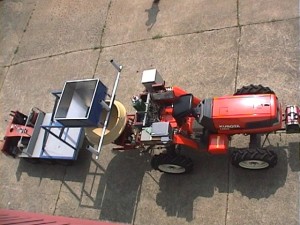 A control method for autonomous vehicles was developed to steer the vehicle to a given goal point. Since four wheeled vehicles have constraints known as non-holonomic constraints, a nonlinear control theory was applied to generate a trajectory that would permit a vehicle to run from a starting point to the goal within these constraints by tracking it.
A control method for autonomous vehicles was developed to steer the vehicle to a given goal point. Since four wheeled vehicles have constraints known as non-holonomic constraints, a nonlinear control theory was applied to generate a trajectory that would permit a vehicle to run from a starting point to the goal within these constraints by tracking it.
In this study, the trajectory control algorithm was applied to automatic fertilizer refilling with an autonomous vehicle equipped with a broadcast fertilizer distributor. Since the proposed control algorithm was an open-loop control, disturbances such as slippage of wheels caused navigation error.
To minimize error, feedback terms were added by linearizing the vehicle’s kinematic equations around a nominal trajectory generated with the open-loop algorithm. A fan beam type laser sensor was used for finding and positioning a fertilizer supplier on which light reflectors were attached for positioning. The accuracy of the control was examined by simulation and field experiments.
The field experiments were repeated by changing postures of the autonomous vehicle with the container at the start point. Results of the field experiment showed that the algorithm could guide the vehicle with satisfactory accuracy for refilling. The main factor in navigation error was limitation in the steering angle of the front wheels.(funded by : Ph.D Program Dissertation – Monbusho Japan 1997-2001 – supervised by : Prof. Tomohiro TAKIGAWA)
Sep
02
2009
 The world demand of raw-silk provides a great opportunity to the development of raw-silk production in Yogyakarta. Recently, only 21% out of the overall world demand of raw-silk is fulfilled, whereas Indonesia contributes only 0.1% per year. The main problem is the lack of quality of raw-silk.
The world demand of raw-silk provides a great opportunity to the development of raw-silk production in Yogyakarta. Recently, only 21% out of the overall world demand of raw-silk is fulfilled, whereas Indonesia contributes only 0.1% per year. The main problem is the lack of quality of raw-silk.
The optimum growth of silkworm depends on micro environments, i.e. temperature, humidity, aeration, and light intensity. The research was aimed, to apply an automated “on/off” control technology in the silkworm rearing environmental monitoring. The result expected is high-grade quality of cocoon. In the research, two different conditions of silkworm growing environments were compared: controlled environment (in the rearing box) and normal environment. Then, from third instar (silkworm`s growth stage) to cocoon`s stage (final stage or fifth instar), temperature and air humidty were set on 240C – 260C and 70% – 80% respectively. While, Aeration and light intensity were ranged 0.1 – 0.3 m/s and 15 – 30 lux for all instar stages (constant) respectively.
The result indicated that there was an increasing the percentage of cocoon skin’s grade in the controlled rearing environment (19.66%), compared to the result of normal rearing environment (18.56%), also there was significantly different result on the thickness of the cocoon produced. (published by : Journal of Agritech, Fac. of Agricultural Technology UGM, Vol. 24 No. 4 2004 – co-authors : Atris Suyantohadi, Hari Purwanto, Radi)
Aug
19
2009
 The control of an autonomous agricultural vehicle operating on unstructured changing terrain includes many objective difficulties. One major difficulty concerns the characteristics of the terrain condition that the vehicle should operate in. Problems can range from the effects of varying terrain conditions on the autonomous vehicle sensors and traction performance through to the need to deal with the presence of unexpected situations.
The control of an autonomous agricultural vehicle operating on unstructured changing terrain includes many objective difficulties. One major difficulty concerns the characteristics of the terrain condition that the vehicle should operate in. Problems can range from the effects of varying terrain conditions on the autonomous vehicle sensors and traction performance through to the need to deal with the presence of unexpected situations.
On unstructured changing terrain, many factors influence vehicle behavior such as terrain slope, lateral slippage, and so on. Therefore, it is necessary to develop a more suitable model for vehicle motion on these terrain conditions. In order to control the vehicle along a course on unstructured changing terrain, it will be developed control software to enable more accurate control.
In this research, we will introduce the difficulty vehicle are facing in unstructured changing terrain and how learning and computational intelligence can help the vehicle to adapt and give them the necessary intelligence they to face the challenges they encounter in their conditions. The developed method to control the vehicle when operating on these conditions is Neuro-Fuzzy Controller.
Neuro-Fuzzy sets and systems constitute one of the most fundamental and influential computational intelligence tools. Given the uncertain and incomplete information an autonomous vehicle has about the condition, neuro-fuzzy rules provide an attractive means for mapping sensor data to appropriate control actions in real time. The success of Neuro-Fuzzy Logic Control (NFLC) is owed in a large part to the technology’s ability to convert qualitative linguistic descriptions into complex mathematical functions and the ability to deal with various situations without analytical model of the environment. The methodology of the NFLC appears very useful when the processes are too complex for analysis by conventional quantitative techniques or when the available sources of information are interpreted qualitatively, inexactly or uncertainly.
The neuro-fuzzy controller is based on the fuzzy membership function-based neural networks (FMFNN) with advantages of fuzzy logic and neural networks, such as inference capability and adoption of human operators, experience with fuzzy logic, and universal approximation and learning capability with neural networks.(funded by : Follow-up Research Program – JASSO Japan 2008/2009 – supervised by : Prof. Tomohiro TAKIGAWA)
Jul
07
2009
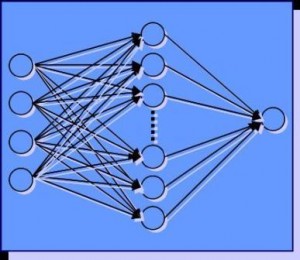 We will start from a simple question, that is “what is a soft computing?”. Soft computing is a collection of intelligent techniques working in a complementary way to build robust systems at low cost. Soft computing differs from conventional (hard) computing in that, unlike hard computing, these techniques are capable of dealing with imprecision, uncertainty, ambiguity, partial truth, approximation, and optimization issues we usually face in real world problems. In effect, the role model for soft computing is the human mind. Main advantages of soft computing are: (i) its rich knowledge representation (both at signal and pattern level), (ii) its flexible knowledge acquisition process (including machine learning and learning from human experts), and (iii) its flexible knowledge processing. Soft computing techniques derive their power of generalization from approximating or interpolating to produce outputs from previously unseen inputs by using outputs from previous learned inputs.
We will start from a simple question, that is “what is a soft computing?”. Soft computing is a collection of intelligent techniques working in a complementary way to build robust systems at low cost. Soft computing differs from conventional (hard) computing in that, unlike hard computing, these techniques are capable of dealing with imprecision, uncertainty, ambiguity, partial truth, approximation, and optimization issues we usually face in real world problems. In effect, the role model for soft computing is the human mind. Main advantages of soft computing are: (i) its rich knowledge representation (both at signal and pattern level), (ii) its flexible knowledge acquisition process (including machine learning and learning from human experts), and (iii) its flexible knowledge processing. Soft computing techniques derive their power of generalization from approximating or interpolating to produce outputs from previously unseen inputs by using outputs from previous learned inputs.
Soft computing employs techniques such as; Neural Networks (NN), Fuzzy Logic (FL), Support Vector Machine (SVM), Machine Learning (ML), Evolutionary Computation (EC) and Probabilistic Reasoning (PR), with the latter subsuming belief networks, chaos theory and parts of learning theory, (Wang and Tan, 1997) in a complementary rather than a competitive way. One example of a particularly effective combination is what has come to be known as “neuro-fuzzy (NF) systems”. Most NF products are fuzzy rule-based systems in which NN techniques are used for purposes of learning and/or adaption (Zadeh, 1994).
Soft computing has been presented not only with the theoretical developments but also with a large variety of realistic applications to many industrial systems, bio-system and agricultural engineering, particularly. Application of soft computing has provided the opportunity to integrate human-like vagueness and real-life uncertainty into an otherwise hard computer program.
For example, soft computing can be applied to irrigation in farming environments, in that case, the application of various intelligent techniques to calculate the water needs of many different cultivation types. The final goal is to develop a decision support system using many intelligent techniques in order to ease the optimization in the use of irrigation water and fertilizers (Botia, et.al. 2000).
The second example is in the era of the modern agricultural development, in order to accurately formulate the simulation growth models of greenhouse plants in different environments, we need to develop an approach to calibrate the growth model of greenhouse crop. One of the intelligent techniques is an adaptive genetic algorithm (GA) can be proposed and evaluated for this issue (Dai, et.al. 2008).
Other example, the control of an autonomous agricultural vehicle operating on unstructured changing terrain includes many objective difficulties. One major difficulty concerns the characteristics of the terrain condition that the vehicle should operate in. Problems can range from the effects of varying terrain conditions on the autonomous vehicle sensors and traction performance through to the need to deal with the presence of unexpected situations. On unstructured changing terrain, many factors influence vehicle behavior such as terrain slope, lateral slippage, and so on. Therefore, it is necessary to develop a more suitable model for vehicle motion on these terrain conditions. In order to control the vehicle along a course on unstructured changing terrain, it will be developed control software to enable more accurate control. Soetiarso (2008) will introduce the difficulty vehicle are facing in unstructured changing terrain and how learning and computational intelligence can help the vehicle to adapt and give them the necessary intelligence they to face the challenges they encounter in their conditions. The developed method to control the vehicle when operating on these conditions is Neuro-Fuzzy Logic Controller (NFLC).
The impact of the successful applications of soft computing will be felt increasingly in the next years. Soft computing is likely to play an especially important role in science and engineering, but eventually its influence may extend much farther. In many ways, soft computing represents a significant paradigm shift in the aims of computing – a shift which reflects the fact that the human mind, unlike present day computers, possesses a remarkable ability to store and process information which is pervasively imprecise, and uncertain.
 This study discusses about monitoring system of hydraulic gradient as a parameter which observed to detect the occurrence of landslide on agricultural land-use in the sub district of Kalibawang, Kulon Progo, Yogyakarta, Indonesia. Hydraulic gradient was observed by using low-cost sensor, gypsum block, combined with AVR LMC555, single chip microcontroller, to read soil moisture content. Sensor node positioned as grid distribution to provide equitable and accurate measurement during soil deformation. Wireless sensor networks technology, IQ Radio Frequency( IQRF) and web databases introduced as an alternative technology which can applied to simplify data transmission and information distribution. Hydraulic gradient was observed with the visual observation of soil moisture content as a head approximation in each sensor node.
This study discusses about monitoring system of hydraulic gradient as a parameter which observed to detect the occurrence of landslide on agricultural land-use in the sub district of Kalibawang, Kulon Progo, Yogyakarta, Indonesia. Hydraulic gradient was observed by using low-cost sensor, gypsum block, combined with AVR LMC555, single chip microcontroller, to read soil moisture content. Sensor node positioned as grid distribution to provide equitable and accurate measurement during soil deformation. Wireless sensor networks technology, IQ Radio Frequency( IQRF) and web databases introduced as an alternative technology which can applied to simplify data transmission and information distribution. Hydraulic gradient was observed with the visual observation of soil moisture content as a head approximation in each sensor node.  Distribution of soil moisture content in grid system displayed in three dimensional graph to represent soil condition during rainfall induced within a certain time. Verification test of the proposed monitoring system was carried out in the laboratory stage to study about the behavior of the hydraulic gradient and performance of monitoring system. Soil layer was prepared using soil test box (0.74 m x 1.85 m x 0.25 m) filled with the equal soil in research site. Rainfall generator was adapted to supply the intensity of rainfall up to 115.5 mm/day. Further development, low-cost sensor and concept of hydraulic gradient as a hydraulic parameter of landslide occurrence can be use for early warning system with combination with other commercial sensors to enhance the accuracy of the system.
Distribution of soil moisture content in grid system displayed in three dimensional graph to represent soil condition during rainfall induced within a certain time. Verification test of the proposed monitoring system was carried out in the laboratory stage to study about the behavior of the hydraulic gradient and performance of monitoring system. Soil layer was prepared using soil test box (0.74 m x 1.85 m x 0.25 m) filled with the equal soil in research site. Rainfall generator was adapted to supply the intensity of rainfall up to 115.5 mm/day. Further development, low-cost sensor and concept of hydraulic gradient as a hydraulic parameter of landslide occurrence can be use for early warning system with combination with other commercial sensors to enhance the accuracy of the system.



